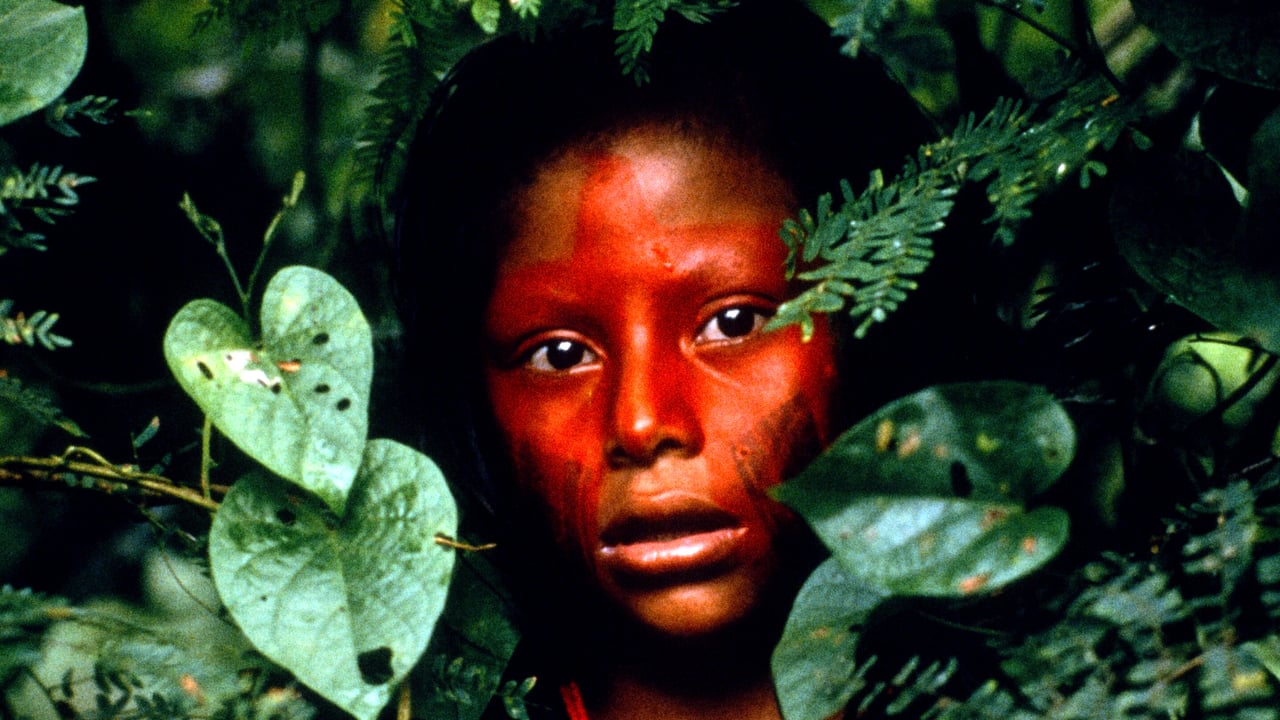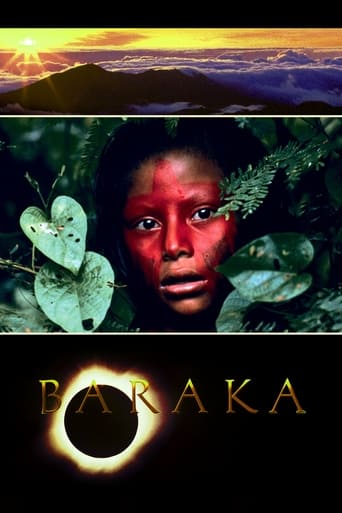

Everybody, especially hipsters, loves those 3-minute YouTube videos with world scenes. So the next logical step is to extend it to 90 minutes. "Who cares about characters, plot, script or anything. It's just easier to throw a whole lot of stock footage together." -Director, and everyone else on the team.This "documentary" attempts to be different but it turns out being different just for the sake of being different and for no good reason. The summary of the "plot" is, this thing you know is bad and this thing you know is good is good. Not insightful and so boring I wanted to tear my eyes out. I had to watch 20 minutes, then take a break, and then another 20 minutes and so on and so forth.
... View MoreIn your opinion what are the most powerful images of the film? How does Ron Fricke's Baraka like the thread that weaves life together? How does Ron Fricke's Baraka content relate to Daniel Quinn's Ishmael? What did you learn from the film? What is the message of the film? What is the value of the film? What mythological story lines does Baraka examine? How is Baraka a "mosaic" of the story Ishmael hopes to tell? How are the images in Baraka & Ishmael Similar? How are they different? What are we doing? Talk about it. Solve Anything. You f****** tw*t. (Mother Culture Hums) + Are you aware? Your connection to your culture (it humming in your ear) & your unwillingness to leave your home culture + Did you see this? -A women seemingly trying to keep a tradition alive in busy streets that were significantly modernized -A assorted group of livestock in a muddy trash pile with people scavenging for food Hey Brah? Counter Culture is Counter to Culture Psychedelic Experience=A Mind manifesting experience Spiritual without religion Doing less for effect (don't show up to war)
... View MoreA bold statement certainly, however Baraka has an immense beauty that is surely universal in appeal. It is a documentary that's without narrative or narration, it captures a veritable plethora of imagery that reminds us that Earth is indeed a baraka, which is Arabic and Hebrew for 'blessing'.Any attempt to derive meaning or identify connection becomes merely incidental as you're presented with the hypnotic scenery that Ron Fricke and his team have captured; it must have been difficult for them to cut their glorious footage down to 97 minutes. The film traverses verdant jungles, epic mountain ranges, sweeping temple complexes, arid deserts, imposing cityscapes and haunting landmarks of evil such as Auschwitz and the Cambodian S-21 prison. Its human subjects are of all colours and creeds, with much of the film focusing on those who are less fortunate and sometimes utterly destitute. It is a sensational and occasionally disturbing cross-section of the planet's landscapes, cultures and history.The stunning wide shots and time lapses are scored with heady ambient music by Michael Stearns. His music is a cacophony of tribal chants, chimes and drums that's vital in creating Baraka's truly sensory immersion. My favourite piece is Baraka Theme, its broad, sonorous notes create a vast scope that perfectly accompanies the boundless panoramas.There are so many moments I could talk about, I could throw effusive adjectives at almost every frame, however I feel mere words can't do it justice. Baraka is a purely cinematic experience that's somewhat futile to describe.However, one memorable sequence I will mention is the factory processing of chicks that's interspersed with the frenetic pace of the Tokyo railway commuters; it is fascinating and ultimately quite unpleasant as the birds' destiny in battery cages is revealed after having their beaks burnt. The camera offers insights into an array of factories, showcasing their subjects' perfectly rehearsed skills in computer hardware assembly, textiles and poultry.It is a film that demands to be shown on good equipment, a film that serves as a benchmark for one's TV or projector. Apparently, it was the first film to receive an 8K transfer, what an awesome experience that must be, most likely better than real life!When Baraka sadly finishes, you eventually move your eyes away from the screen for the first time in 97 minutes and realise that you've been dead still the whole time as you check your watch, surprised to see that many hours haven't passed. It is a triumph that the moving image alone can achieve such engrossment.86%www.hawkensian.com
... View MoreHow does a movie with no words or characters have such a huge impact? I still don't really know but Baraka had that impact on me. This movie came out in 1992 and shows life in many shows and forms. It is a strange but intriguing genre of film but it is amazing. Baraka means hope in English but what it actually means is up to the viewer. From the streets of New York, to tribes in Africa, to clouds floating above mountains, Baraka dives deep into the planet we live on and really made me think.The shots in this movie, with the music intertwined, were beautiful. A New York Street is shown with the traffic moving like clockwork while drums are playing almost in sync with the traffic. The entire hour and a half movie is like this. This movie touches upon every religion and group of people we have on Earth. The audience sees the different people in the world but we also see how similar we are. Yes a typical American lifestyle is a lot different than the people in other countries that have tattoos and piercings all over their body, but seeing how we share similar problems is brilliant. Throughout the movie we see the positive and negative aspects of our world, past and present. People are shown happy and sad but no matter what the culture there are shots of people staring right into the camera and into the depths of my soul. They break the cinema wall, in a regular movie actors never stare into the camera, but with Baraka regular people stare right into the camera and the emotional impact is huge. Children stare and you wonder what they are thinking about, are they happy or sad. Most stares are blank and innocent. It shows how innocent people really are and how we take those innocents away.This movie really made me think about the word we live in and how people treat each other. People are so cruel to each other for no reason. People discriminate based on religion, why? This movie shows each religion I can think of and they basically follow the same principal. We as a species are so similar to each other but we treat one another like garbage. There are shots of Auschwitz and the Cambodian massacre. Human skills and bones still sitting there. These people were killed for no reason and as a viewer it's sad. I loved this movie. It made me think and want to change. I don't judge people but it made me want to make a greater effort to treat people better in general.Nature of our world is also beautiful. There are shots of animals, specifically monkeys and it is adorable. There is a sequence very early on of a monkey hanging out in a hot bath and it just sits there. A raindrop slightly falls on his nose and it just stars at it as if it's annoyed. It is subtle things like this that I really loved. Nature is truly beautiful if you look at it the right way. Shots of nature were the ones I liked the best, especially waterfalls. I don't know why but I love waterfalls. I also loved the clouds running over mountains like a strong river current. It looked like somebody was stretching out a cotton ball for miles and miles. Music makes the movie. If you don't believe me, then you're dumb for one. Watch this movie and tell me you didn't like the music in this movie. Philip Glass composed the music and after I saw this movie I immediately got the soundtrack. It's so beautiful and captivating. It captures each individual moment perfectly. Sometimes there are different cultures singing or chanting and sometimes it is natural sound from the world itself. It's repetitive and slow but effective.Overall, Baraka is a masterpiece. I have never seen a film like this but I want to see more. This is a rare and beautiful genre that makes you think about the world we live in. A movie like this can't be too long and it can be a little boring at times but I watched this movie in the "proper" state of mind. I strongly suggest you watch this movie in the "proper" state of mind, you won't regret it. I will see this movie again and the upgraded blu ray made it ten times better. The picture quality was the best I have ever seen and the sound quality was right up there as well. Baraka gets the WillyT Seal of Approval and the mind blow of the week. Words are not enough to describe this movie enough and it's fitting because there is not one word of scripted dialogue in the film at all.
... View More